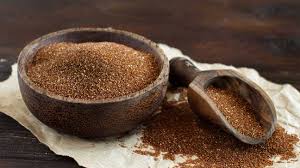The Rise of Ancient Gluten-Free Grains as Superfoods
In recent years, the global food landscape has seen a remarkable shift toward clean eating, sustainable nutrition, and dietary inclusivity. Amid these trends, a powerful resurgence of ancient grains has captured the attention of health enthusiasts, dietitians, and food innovators alike. What sets these grains apart? Beyond their storied past, ancient grains such as amaranth, teff, sorghum, millet, and buckwheat have emerged as modern-day superfoods—especially for those following a gluten-free lifestyle.
This two-part series, we will explore the origins, nutritional benefits, cultural relevance, and growing popularity of these grains. This foundational understanding sets the stage for Part 2, where we’ll dive into their applications in modern diets, recipes, market trends, and their role in sustainable agriculture.
What Are Ancient Grains?

Ancient grains are cereals and seeds that have remained largely unchanged over the last several hundred—or even thousands—of years. Unlike modern wheat, which has been selectively bred for yield and baking properties, ancient grains have preserved much of their original genetic makeup. This stability has allowed them to retain a unique combination of nutrients, flavors, and functional properties.
Common examples include:
- Amaranth – once a staple of the Aztecs, amaranth is a tiny seed high in protein and rich in lysine.
- Teff – native to Ethiopia, teff is the foundation of injera and known for its high calcium and iron content.
- Millet – a drought-resistant grain widely used in Asia and Africa.
- Sorghum – versatile and gluten-free, sorghum is used in porridges, flatbreads, and beverages.
- Buckwheat – technically a seed, buckwheat is rich in antioxidants and is commonly used in pancakes and soba noodles.
These grains have long been integral to various indigenous and traditional diets, and their revival in the modern world marks a return to more wholesome, nutrient-dense ingredients.
Gluten-Free and Nutrient-Dense
One of the key drivers behind the resurgence of ancient grains is the increasing demand for gluten-free alternatives. Whether due to celiac disease, gluten sensitivity, or personal choice, millions of people are seeking options beyond refined wheat. Ancient grains offer a compelling solution—not only are they naturally gluten-free, but they also boast an impressive nutritional profile.
For example:
- Amaranth is around 14% protein and contains all nine essential amino acids.
- Teff is high in resistant starch and helps in blood sugar regulation.
- Sorghum contains phytochemicals with anti-inflammatory properties.
- Millet is a good source of magnesium, phosphorus, and B vitamins.
- Buckwheat has a high content of rutin, an antioxidant beneficial for cardiovascular health.
These grains are typically higher in fiber, protein, and micronutrients than refined wheat and corn. Their inclusion in a balanced diet may support digestion, cardiovascular function, and sustained energy levels.
Historical and Cultural Roots

The appeal of ancient grains goes beyond nutrition—they also tell stories of civilizations past. Teff, for instance, has been grown in the Horn of Africa for over 5,000 years and is central to Ethiopian identity. Amaranth was revered by the Aztecs and Incas for its spiritual significance and strength-giving qualities. Sorghum, with origins in Africa, has served as a crucial crop in arid climates where little else thrives.
By reconnecting with these grains, modern eaters engage with a form of culinary archaeology—resurrecting foods that once nourished empires and sustained generations. This cultural dimension has inspired chefs, food bloggers, and nutritionists to weave historical context into recipes and menus.
Sustainability and Agricultural Benefits
Another reason ancient grains are gaining ground is their resilience. Many of them can thrive in poor soils, require less water, and are more pest-resistant than conventional cereal crops. Millet and sorghum, for example, are especially valuable in regions impacted by climate change due to their drought tolerance and adaptability.
Their cultivation can contribute to:
- Soil regeneration through deep root systems
- Biodiversity by reintroducing lesser-known crops
- Reduced chemical use thanks to natural pest resistance
As sustainable farming becomes an ever-urgent priority, ancient grains offer a pathway to feeding the planet while preserving ecological balance.
The Return to Wholesome Eating
With rising awareness of processed food’s health consequences, many consumers are turning toward minimally processed, nutrient-dense options. Ancient grains align perfectly with this ethos. Their earthy flavors, chewy textures, and versatility in cooking make them ideal for everything from breakfast porridges to gluten-free baked goods and hearty salads.
Brands and product developers are capitalizing on this interest. Today’s supermarket shelves are filled with amaranth crackers, teff breads, sorghum-based cereals, and buckwheat granolas. Consumers want transparency, nutrition, and taste—and ancient grains deliver on all fronts.
Ancient Grains in Contemporary Cuisine

Today’s chefs, home cooks, and recipe developers are celebrating the versatility of ancient grains by incorporating them into a wide range of dishes. From gourmet restaurants to everyday home kitchens, these grains are redefining what gluten-free food can taste and feel like.
Take amaranth, for instance—it’s being used in protein-rich pancakes, crispy crackers, and savory pilafs. Teff flour has found its way into gluten-free pizza crusts and waffles. Sorghum is a favorite for brewing gluten-free beer, while millet is making a comeback in porridge bowls and snack bars.
These grains work well in:
- Hot cereals and porridges
- Grain bowls and salads
- Flatbreads and crackers
- Soups and stews
- Desserts like cookies and muffins
Because of their robust flavors, each grain brings a unique character to the table. Chefs often combine them with modern ingredients like kale, avocado, tahini, and fermented vegetables to elevate both taste and nutritional value.
Global Recipes and Culinary Fusion
One of the most exciting aspects of this grain revival is the global perspective it invites. Ancient grains are used in traditional dishes from Africa, South America, and Asia, and now they’re inspiring a new generation of fusion recipes.
Examples include:
- Ethiopian Injera made with 100% teff flour
- South Indian Millet Dosa as a gluten-free breakfast alternative
- Mexican Alegría—a traditional amaranth sweet treat
- Sorghum tabbouleh as a Mediterranean-inspired gluten-free dish
- Buckwheat crêpes from France served with savory fillings
This cultural blend celebrates diversity while educating people about the origins and stories behind their food. Food bloggers and influencers are sharing these recipes across platforms like YouTube, Pinterest, and TikTok, making ancient grains trendy and accessible.
Health-Conscious Consumer Trends
The growing awareness of gut health, anti-inflammatory diets, and plant-based living has fueled the demand for ancient grains. Gluten-free no longer means sacrificing flavor or nutrition—it’s about choosing better.
Key consumer trends include:
- Low-GI and diabetic-friendly diets choosing teff and buckwheat
- High-protein vegan diets embracing amaranth and quinoa
- Prebiotic and gut-friendly products made with millet and sorghum
- Clean label and allergen-free demand driving innovation
Products now come with transparent sourcing information, eco-friendly packaging, and science-backed nutritional claims. This trend reflects a larger desire for wellness-driven eating and responsible consumerism.
The Business and Market of Ancient Grains
The market for ancient grains has experienced double-digit growth over the past decade. According to industry reports, global sales of gluten-free products are projected to exceed $13 billion by 2026—with ancient grains leading the way.
This has opened up opportunities for:
- Gluten-free bakeries and food startups
- Farmers shifting to heritage crop cultivation
- Major brands launching grain-based snacks, cereals, and flours
- Restaurants offering ancient grain-based menu sections
Brands like Bob’s Red Mill, Jovial, and Thrive Market have made ancient grains widely available in both brick-and-mortar and online retail spaces. There is also a surge in direct-to-consumer models, subscription boxes, and farm-to-table grain delivery services.
Challenges and Future Outlook
Despite their benefits, ancient grains face challenges. Limited commercial farming, higher production costs, and consumer unfamiliarity can hinder adoption. Education and accessibility remain key to mainstream success.
The future, however, looks promising. Food scientists are developing new blends that enhance taste and baking properties. Agronomists are exploring climate-adaptive strains to increase yield. Meanwhile, governments and NGOs are promoting heritage grains as tools for food security and biodiversity.
Predicted developments include:
- Ancient grain protein powders for athletic nutrition
- Hybrid flours that combine different ancient grains for functional baking
- Biofortified grains with enhanced iron and zinc content
- Expanded culinary education on using ancient grains in daily cooking
The rise of ancient gluten-free grains is not just a nutritional fad—it’s a multidimensional movement rooted in history, health, sustainability, and culture.
Stay tuned for recipes, global trends, product spotlights, and interviews with food innovators embracing the ancient grain renaissance.
The rise of ancient gluten-free grains marks a return to traditional wisdom and a step forward into a healthier, more sustainable food future. These grains offer more than just gluten-free alternatives—they embody culture, nutrition, innovation, and environmental consciousness.
